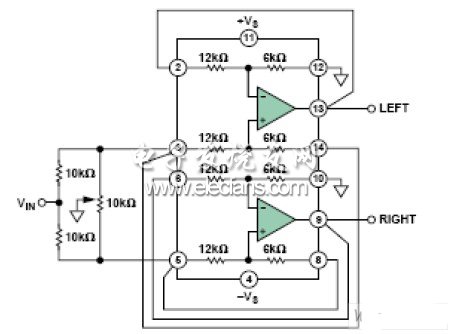Figure 1 shows an audio Panpot circuit that responds to the setting of the potentiometer by continuously changing the position of the mono audio signal between the left and right stereo channels. Low cost and low distortion are important considerations for audio circuits. The dual-channel low-distortion differential amplifier AD82731 uses internal gain setting resistors to ensure excellent matching between the two channels. It requires no external components, and each channel is configured as two high-performance amplifiers with a gain of 3. In the audio frequency range, the total harmonic distortion is less than 0.0007%.
Although this circuit can be built in a discrete manner, integrating amplifiers and resistors on a single chip can bring many benefits to circuit board designers, such as better performance specifications, smaller PCB area, and lower production costs.

Figure 1. Audio Panpot amplifier
In this circuit, the signal is distributed between the two amplifiers through a 10 kΩ series resistor. Insert a vernier grounded potentiometer between the two non-inverting inputs. The combination of a potentiometer and a 10 kΩ resistor constitutes a light load and is easily driven by most signal sources. The gain configuration of the amplifier is 3. When the potentiometer cursor is located at either end, one input terminal is grounded, so no signal is transmitted to the corresponding output terminal. The voltage at the other input is VIN / 2, so its output is 1.5 & TImes; VIN. When the cursor is in the middle position, the input of both amplifiers is VIN / 3, so the output of each amplifier is VIN. In this way, by moving the cursor (either mechanically or electronically), the signal level on one channel changes continuously from 0 to 1.5 & VIN, and the signal level on the other channel changes continuously from 1.5 & TImes; VIN to 0. To the listener, the sound source seems to move from one channel to another between sound levels. Therefore, the sound image or the apparent source of sound can be located anywhere between the left and right speakers.

Figure 2. Total harmonic distortion and noise versus frequency
Figure 2 shows the total harmonic distortion and noise over the entire audio range. The error becomes larger as the frequency increases, but the total error at 20 kHz is still less than 0.0007%. Figure 3 shows the connection diagram of the IC.

Auto Tail & Licence Plate Light
Tail light is a red light on the back of a car that makes it possible for the vehicle to be seen in the dark. Licence plate light bright sign on a vehicle that shows its registration number. The rear lights are shown in the front of the car in front of the vehicle and show the location of the two workshops, so they are mounted on both sides of the vehicle. Japan's safety regulations are the same as those of European standard ECE7. The light intensity near the center is 4~12 CD and the light color is red. 1. With sufficient light intensity, the car taillight can clearly distinguish the signal from the driver or pedestrian of other vehicles even in bright sunlight. 2, night driving, tail lights light will not produce glare to other vehicle drivers or pedestrians and uncomfortable feeling As the ideal tail lights should have the following characteristics: (1) high luminous intensity and reasonable distribution of light intensity; (2) fast forward time of luminous rise; (3) long life, no maintenance, low energy consumption; (4) strong switch durability; (5) good impact resistance.
Auto Tail & Licence Plate Light
Auto Tail,Licence Plate Light,LED Tail Light,Waterproof Licence Plate Light
Heshan Jianhao Lighting Industrial Co., Ltd. , https://www.sunclubtw.com